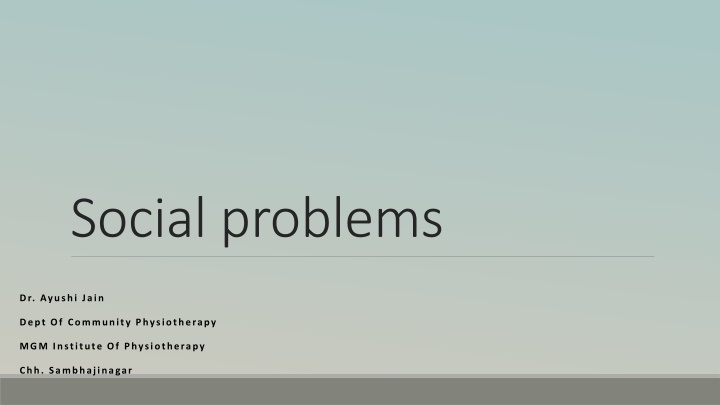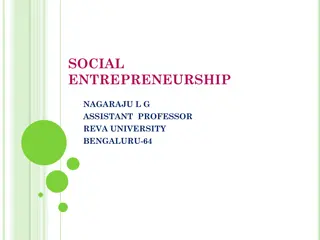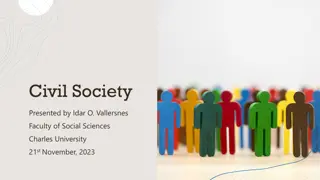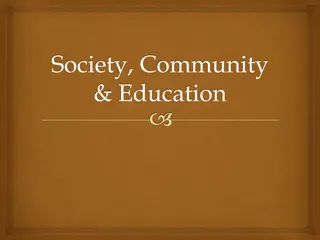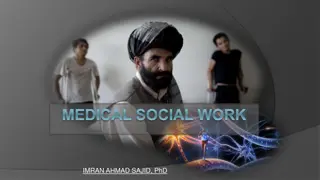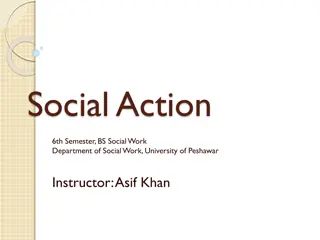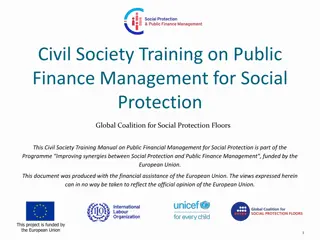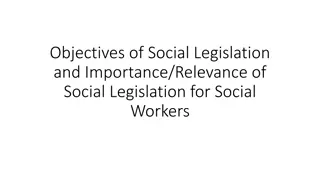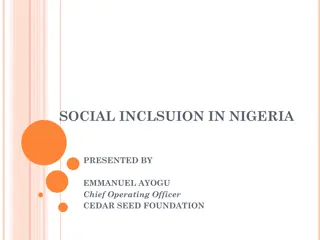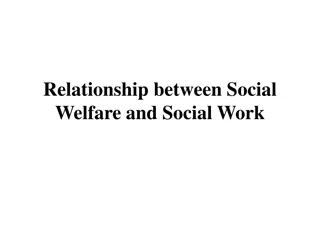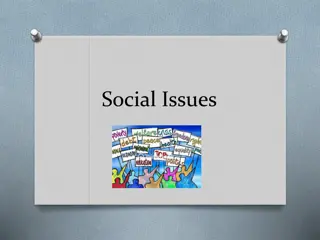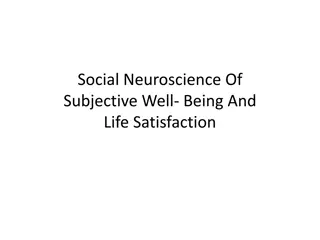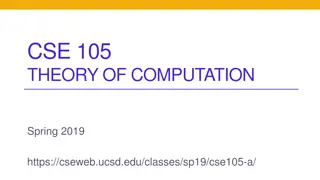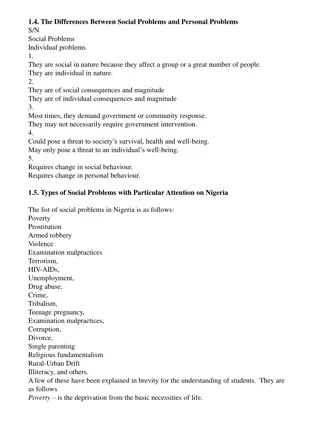Social Problems and Their Impact on Society
Social problems arise due to a society's failure to adapt its institutions and culture to growing needs, leading to behaviors or conditions considered undesirable. These issues hinder social progress and lead to disorganization within communities. Social problems necessitate changes to the existing order, with implications for individual and social disorganization. Classification includes economic, biological, psychological, and cultural problems, such as unemployment, poverty, diseases, and societal challenges. Understanding different types of social problems like cyclical and voluntary unemployment is essential for addressing these issues.
Download Presentation

Please find below an Image/Link to download the presentation.
The content on the website is provided AS IS for your information and personal use only. It may not be sold, licensed, or shared on other websites without obtaining consent from the author.If you encounter any issues during the download, it is possible that the publisher has removed the file from their server.
You are allowed to download the files provided on this website for personal or commercial use, subject to the condition that they are used lawfully. All files are the property of their respective owners.
The content on the website is provided AS IS for your information and personal use only. It may not be sold, licensed, or shared on other websites without obtaining consent from the author.
E N D
Presentation Transcript
Social problems Dr. Ayushi Jain Dept Of Community Physiotherapy MGM Institute Of Physiotherapy Chh. Sambhajinagar
Social problems are the result of the failure of a society to adapt its social institutions and culture to its growing needs. Social problems are behaviour pattern or conditions that are considered objectionable or undesirable by many members of a society. With the increase in number of social problems the society cannot work smoothly or social progress is hampered/hindered and social disorganisation exists. When an individual or a group of individuals is disorganised and is not functioning according to the norms laid down by the society, the social problem is said to exist.
DEFINITION A social problem is any deviant behaviour in a disapproved direction of such a degree that it exceeds the tolerance limit of the community Lundberg Significant discrepancy between social standards and social actuality . Morally wrong but the majority or substantial minority within the society Green
Every Social Problem Implies Three Things 1. Something should be done to change the situation, which constitutes a problem. 2. The existing social order has to be changed to solve the problem. 3. The situation regarded a problem is undesirable but is not inevitable
Nature Individual Social disorganisation Social problem Disorganisation Social Social problem Individual disorganisation. Disorganisation Thus social disorganisation is always the resultant of some breakdown in the social organisation. Social problems are the conditions threatening the well being of society.
Classification Economic problems. Eg: Poverty, unemployment, dependency. Biological problems. Eg: Physical diseases and defects. Psychological problem. Eg: Neurosis, psychosis, epilepsy, feeble mindedness, suicide, alcoholism. Cultural problems. Eg: Problems of the aged, the homeless and the widowed, divorce, illegitimacy, crime and juvenile delinquency.
UNEMPL0YMENT UNEMPL0YMENT Non-availability of work even though there is a desire to do it
Types Cyclical Unemployment Voluntary unemployment Sudden Unemployment Arising from Shortage of Capital, Equipment or Other Complementary Resources Arising from Failure in Industry or Business Involuntary unemployment Arising from Seasonal Business Subjective unemployment Frictional Unemployment Objective unemployment Technical unemployment Temporary unemployment
Causes Personal Factors Defective education and training Defects in character Throwing responsibility on wrong shoulders. Physical disability, deformity Age Mental and moral deficiency of the labourers Illness Mental illness Vocational unfitness Accidents
Technological factors Economic factor Limited land Excessive increase in the population Lack of Subsidiary Industries Unscientific cultivation
Remedial Measures for Unemployment Removal of Personal Disabilities Vocational education and educational planning Economic development
POVERTY Poverty exists when one is not able to get sufficient food and other necessities of life. Poverty line: It is determined by the customs and mode of living. It is relative to the scale of living and conditions of others in a given group culture, or status. Further, the scale of living may be different in different social groups in the same culture and each group tends to formulate a standard of living, which is considered necessary for a decent living. The actual scale of living compared with the standard of living measures the extent of poverty.
Types absolute relative
Causes of Poverty Incapacity of the individual Adverse physical environment Economic factors War Personal factors accidents, illiteracy, mental diseases, sickness, demoralisation, large family Geographical causes Economic causes Social factors etc
The poverty alleviation programmes launched by Indian government are 1. Integrated Rural Development Programme (IRDP) 1978- 79. 2. Training of Rural Youth for Self-employment (TRYSEM) 1979. 3. Development of Women and Children in Rural Areas (DWACRA) 1979. 4. National Rural Employment Programme (NREP). 5. Rural Landless Employment Quarantee Programme (RLEGP). 6. Jawahar Rozgar Yojana. 7. Drought Prone Areas Programme 1973.
The dowry system in India refers to the durable goods, cash, and real or movable property that the bride's family gives to the groom, his parents and his relatives as a condition of the marriage. The dowry system can put great financial burden on the bride's family. In some cases, the dowry system leads to crime against women, ranging from emotional abuse and injury to even deaths.
The payment of dowry has long been prohibited under specific Indian laws including the Dowry Prohibition Act 1961 approved by the Parliament of India and subsequently by Sections 304B and 498Aof the Indian Penal Code. The Dowry Prohibition Act 1961 defines dowry: "Dowry means any property or valuable security given or agreed to be given either directly or indirectly - (a) by one party in marriage to the other party in marriage; or (b) by the parents of either party to a marriage or by any other person to either party to marriage or to any other persons;at or before or after the marriage as consideration for the marriage of the said parties, but does not include dower or mahr in the case of persons to whom the Muslim Personal law applies."
Causes Economic factors Social factors Religious factors
Illiteracy A person is illiterate who cannot with understanding both read and write a short simple statement on his everyday life. A person is functionally illiterate who cannot engage in all those activities in which literacy is required for effective functioning of his group and community and also for enabling him to continue to use reading, writing and calculation for his own and the community s development.
Self Help Groups (SHGS) All for all is the basic concept. Mainly concerned with poor (weaker sections concerning to women) and it is for the people, by the people and of the people. It is working under micro level, and generates self-confidence, self-security, self-reliance and social defense. It encourages the women volunteers to organize themselves in a group for eradication of poverty of its members. Every month each member of the group should save a minimum of Rs 10 to 15/- or more till six months and thus become eligible to apply for a loan to start income generating activities like dairy farming, agriculture, sericulture, poultry, goat and sheep rearing.
Objectives To inculcate the habit of saving and banking among rural women To improve moral thrust and confidence between bankers and rural women To develop team spirit, active participation of group members in welfare activities.
Principles Social homogeneity Social support Internality Experimental learning Social movement Self determination Active participation
Advantages Total group members involvement is organization of activities Possible for close monitoring of the activities Positive social processes will be activated Access to and efficient use of common pool resources Activation of democratic process where group interaction, reciprocity and decision-making process will be maintained Regulated by mutually accepted group rules.
Other - Beggary Alcoholism Problems with females Overpopulation
SOCIAL PLANNING Man must plan, based on facts, analysis, scientific approach to deal effectively with the problem faced by him. Man can control his destiny as the social problems are man made origin and he can adequately treat it. A plan is in achievement to be made within a fixed period of time. It is based on practical approach and a means of social progress.
